Last updated: December 13, 2017
Place
Upper South Amana Communal Kitchen

Photo courtesy of Amana Colonies Convention and Visitors Bureau
Throughout the communal period the Amana villages had over 50 kitchen houses. These buildings resembled other residential dwellings except for an extension to the side. The kitchens and communal dining rooms were located in the extension, while the kitchen boss lived in the main part of the house. Several nearby homes were assigned to one kitchen house where the families received their meals. No one prepared individual family meals, although most families did begin to take their meals home to eat in the last years of the communal period.
Each kitchen house had a kitchen boss, and neighborhood women who were assigned to cook, garden, serve, and clean on a rotating schedule. The kitchens contained large brick stoves with an iron top, as well as troughs for running water. The village butcher made deliveries of meat products, the baker brought bread, the cow barn supplied milk, and flour and sugar came from the general store. Each kitchen had a nearby garden where vegetables were grown. Chicken houses, usually of unpainted wood and often constructed with a shed-roof, were nearby; although a brick chicken house survives in South Amana. Some kitchens had small sheds where the women could store their garden tools.
